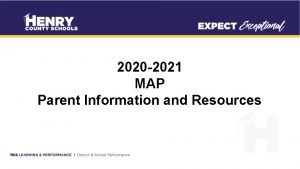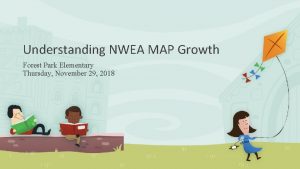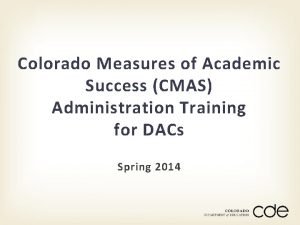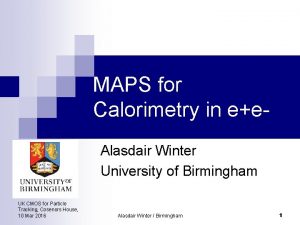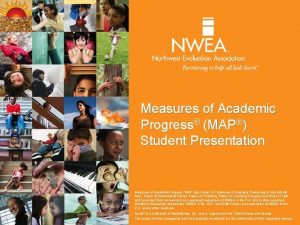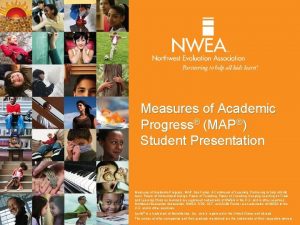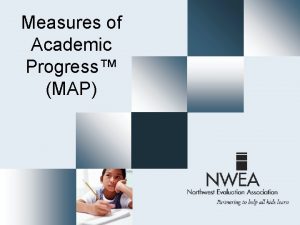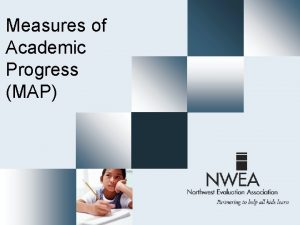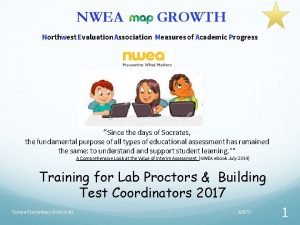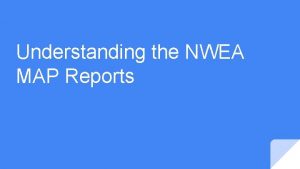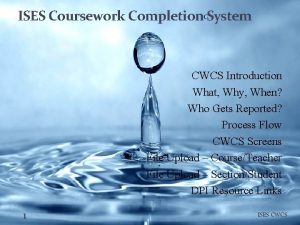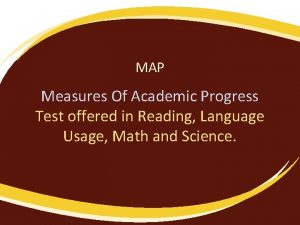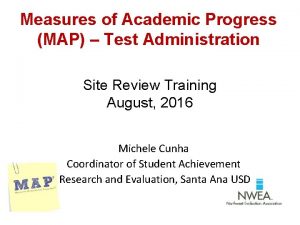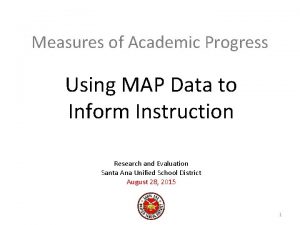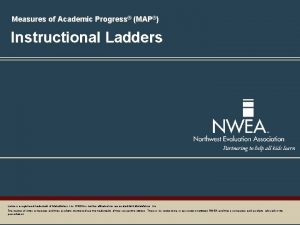NWEA Measures of Academic Progress MAP CWCS Winter














- Slides: 14

NWEA Measures of Academic Progress (MAP) CWCS Winter 2017

Role of Network Mission & model: Set organization-wide purpose, mission, values, CWC Way and CWC Academic Model, and mission critical performance thresholds. Strategic planning: Facilitate annual network strategic planning, influence regional planning through rigorous thought partnership, and align network and regional plans. Accountability: Assess progress toward strategic plans and hold regions accountable for adherence to mission, vision, principles, and mission-critical performance thresholds. Sharing: Build and facilitate network-wide learning community. Innovation: Facilitate the development and piloting of new ideas or the improvement of existing solutions. Communications: Strengthen CWC’s brand internally and externally and influence the national narrative. Growth & Expansion: Seek out and capitalize on opportunities for expanding the foundational pillars of CWCS. Note: Mandated shared services & Operational Efficiencies are not listed.

Reasons why we use NWEA MAP 1. Continues to meet State and LAUSD requirements for Common Core aligned interim benchmark assessments 2. Provides evidence on how CWC students are doing compared to their student peers across the nation 3. Includes features (i. e. adaptive nature of NWEA MAP) that can provide teachers an additional resource to understand skill gaps of students 4. Provides alignment across schools, regions and network, and offers school to school comparisons

State and District each had requirements related to assessments Both state and district agencies outlined requirements for a benchmark assessment at a school site: • State District In 2013, CA temporarily suspended most standardized testing to ease transition to Common Core Through the Oversight and Renewal processes, LAUSD provides the following guidance: • Education Code requires charters to demonstrate academic growth school-wide and in subgroups as a primary factor for renewal • Schools needed Common Core aligned interim assessments to track progress at the student level and school level • Schools must provide quantitative performance data related to academic performance and progress assessment, monitoring, and analysis • LAUSD considers only such data that is derived from standardsbased high quality standardized or widely accepted assessments

CWC needed an assessment that meets several requirements Requirements State District CWC Aligns with Common Core State Standards ✓ ✓ ✓ Provides student-level and school-level views ✓ ✓ ✓ High-quality, standardized and widely accepted ✓ ✓ Meets requirements for Renewal/Oversight processes ✓ ✓ Provides additional features that support CWC model ✓

NWEA MAP meets many of these requirements Adaptive Instructional Readiness RIT Scale NWEA MAP: Normative Measures of Academic Progress State and District Needs

Nation-wide sample of data Normative or Norm. Referenced • NWEA “norm data” includes samples from over 10 million students across the country • Scores are ranked from low to high performance, forming a normal distribution reflected below A student at grade level (a typical score) falls at the 50% percentile of the normative data group. CWC can measure results against a larger, nation-wide sample.

Achievement scale across grade-levels RIT Scale • Equal interval scale of achievement • Used to show growth over time for a student • Grade-level independent Grade-Level Norms RIT 250 11 10 9 8 7 6 5 4 Grade 3 Student RIT = 190 3 2 = Grade 6 Student RIT = 190 1 K 120 Grade-level independent means a 3 rd grader with a RIT of 190 and a 6 th grader with a RIT of 190 are ready for the same instruction. Note: Sample data only.

Adaptive assessment format Adaptive Instructional Readiness • Provides students with an assessment tailored to his/her level of proficiency • NWEA is NOT an assessment for determining mastery of skills, but provides a road map for students towards achieving mastery 210 The student begins to get mostly half correct and half incorrect, leading to the area where s/he is ready to learn. 200 190 Overall, the student exceeds Grade Level Performance for Grade 3. Grade Level 180 170 Correct Answer Increases difficulty of next question Test Questions for Grade 3 Category 1 Note: Sample data only. 2 3 4 Incorrect Answer Decreases difficulty of next question

Let’s look at an example for one student Mark took the Winter NWEA MAP Assessment in Math. We will look at three key data points: Normative (Achievement) Mark’s Winter RIT score of 205 is at the 70 th percentile relative to other 3 rd grade students. Growth Mark gained 9 RIT units since the Fall MAP test. Typical growth for students starting at the same level (other 3 rd grade students with Mark’s RIT score during the Fall) was 5 points. Predictive (Projected Proficiency) Mark’s score indicates he is on track to a Level 3 on the Spring SBAC. As shared in our Trimester Reports, we would like to see students demonstrate growth regardless of her/his starting achievement level (relative to NWEA’s normative data). High Growth High Achievement Low Growth Low Achievement Low Growth High Achievement Growth High Growth Low Achievement Note: Sample data only.

Example: Normative (Achievement) Data Normative (Achievement) Mark’s Winter RIT score of 205 is at the 70 th percentile relative to other 3 rd grade students. Math (RIT Values) 2015 Grade Fall T 1 Winter T 2 Spring T 3 K 140. 0 151. 5 159. 1 1 162. 4 173. 8 180. 8 2 176. 9 186. 4 192. 1 3 190. 4 198. 2 203. 4 4 201. 9 208. 7 213. 5 5 211. 4 217. 2 221. 4 6 217. 6 222. 1 225. 3 7 222. 6 226. 1 228. 6 The Table above lists the typical score for each grade level over the course of the school year. Note: Sample data only. RIT Score 167 198 205 229 Percentile 1 st 50 th 70 th 99 th Mark’s Winter Math Result The graphic above illustrates Mark’s score relative to NWEA’s Winter Normative Math data for Grade 3 students.

Example: Growth Data Growth Mark gained 9 RIT units since the Fall MAP test. Typical growth for students starting at the same level was 5 points. Mark Winter RIT Score 205 Typical Grade 3 Winter RIT Score 201 Mark Fall RIT Score 196 Mark exceeded the projected (typical) growth RIT score of 201 given the following factors: Grade Level: 3 rd Starting RIT Score: 196 Subject: Math 3 rd Grade MAP Math Fall Note: Sample data only. Met Growth? Yes 3 rd Grade MAP Math Winter

Example: Predictive (Projected Proficiency) Data Predictive (Projected Proficiency) Mark’s score indicates he is on track to a Level 3 on the Spring SBAC. Percentile when MAP is take in Winter prior to SBAC Grade Level 1 Level 2 Level 3 • NWEA’s linking study provides the Grades 3 - 8 cut scores on MAP reading and math that correspond to the benchmarks on the Smarter Balanced ELA and Math tests (SBAC) • The cut scores can be used to predict students’ most probable SBAC performance category, based on their observed MAP scores • NWEA provides different cut scores depending on when students take the NWEA assessment (Fall, Winter or Spring) Level 4 Range of Percentile Ranking 3 1 - 23 24 - 51 52 - 80 81 - 99 4 1 - 20 21 - 58 59 - 85 86 - 99 5 1 - 31 32 - 68 69 - 85 86 - 99 6 1 - 30 31 - 61 62 - 81 82 - 99 7 1 - 33 34 - 65 66 - 84 85 - 99 The Table above provides SBAC Math benchmarks if the Math MAP were taken in the Winter administration. Note: Sample data only.

Trimester Reporting: Data to be reviewed Alignment to model Trimester 1 Trimester 2 Trimester 3 Enrollment: Overall, Race/Ethnicity, and Program Subgroup x x x Attrition: Overall, Race/Ethnicity, and Program Subgroup x x x Count: Overall and Race/Ethnicity --- x --- Regrettable Attrition: Overall and Race/Ethnicity x x x Projected Proficiency to State Assessment (& Compared to Actual) x x x Percentage of Students On or Above the National Average x x x Percentage of Students Who Met Projected Growth Target x x x Student-level Median Achievement Percentile Ranking x x x Student-level Median Conditional Growth Percentile Ranking x x x --- x x Percentage of Students Who Score At or Above Average x --- Percentage Change of Students Accepted by Peers x x --- Measure Student Diversity Staff NWEA Measures of Academic Progress Understanding Fountas & Pinnell Percentage of students on or above grade level (instructional level) SELweb Connection Stakeholder Feedback Leadership, Staff and Parent Surveys
 Nwea map.org
Nwea map.org Physical progress and financial progress
Physical progress and financial progress Forest park symbaloo
Forest park symbaloo Nwea norms 2020
Nwea norms 2020 Melinda orta nwea
Melinda orta nwea Rapid guessing nwea
Rapid guessing nwea Winter kommt winter kommt flocken fallen nieder
Winter kommt winter kommt flocken fallen nieder Es ist kalt es ist kalt flocken fallen nieder
Es ist kalt es ist kalt flocken fallen nieder Winter kommt winter kommt flocken fallen nieder
Winter kommt winter kommt flocken fallen nieder Colorado test nav
Colorado test nav Repeated measures design
Repeated measures design Dbd winter map
Dbd winter map Status progress report
Status progress report Progress application server for openedge
Progress application server for openedge Progress developer studio for openedge download
Progress developer studio for openedge download
